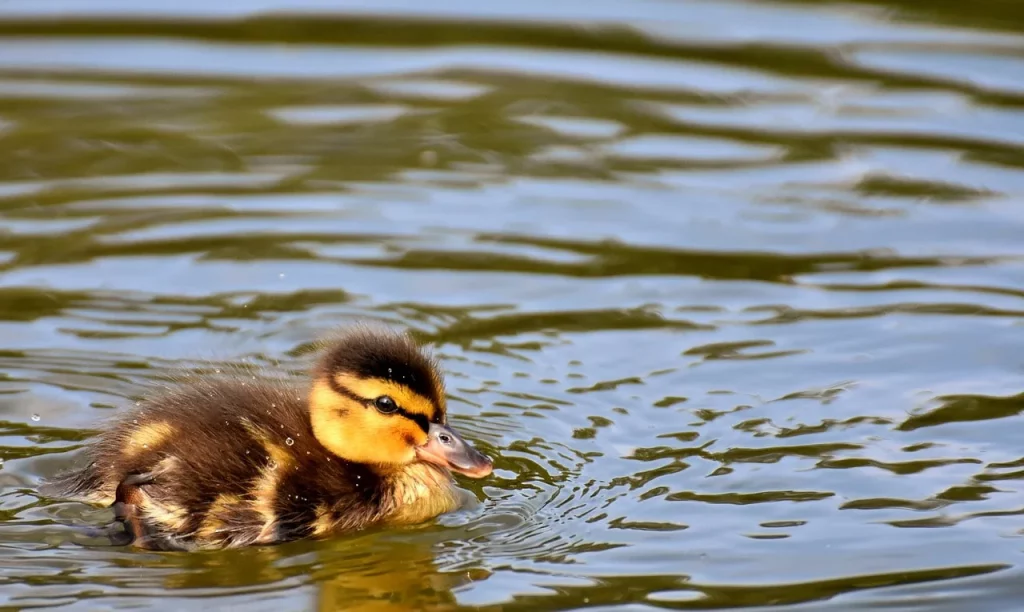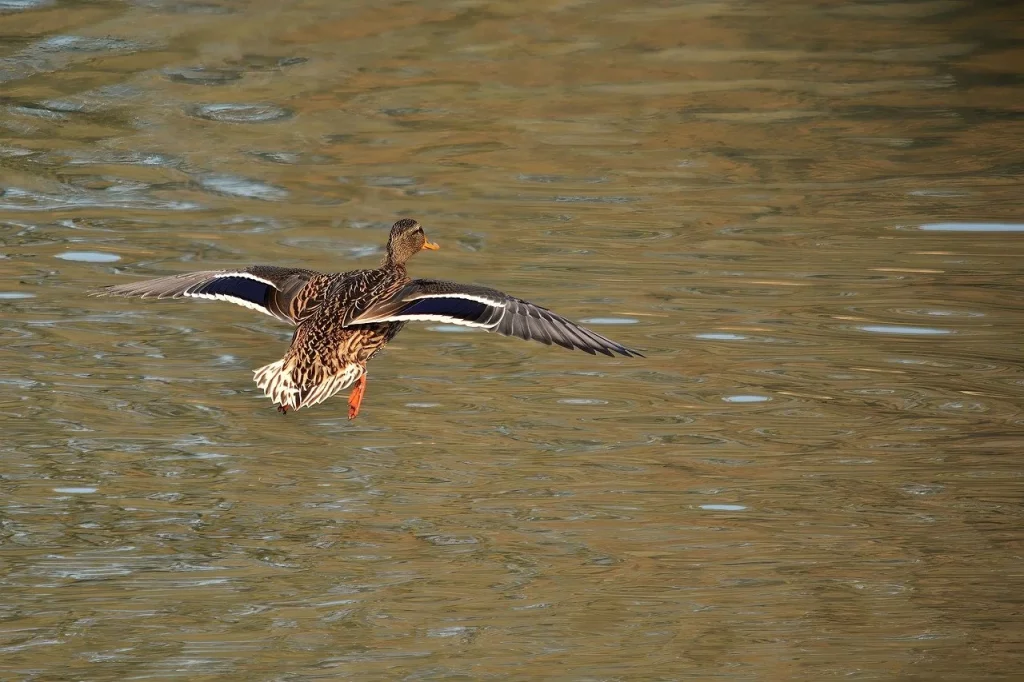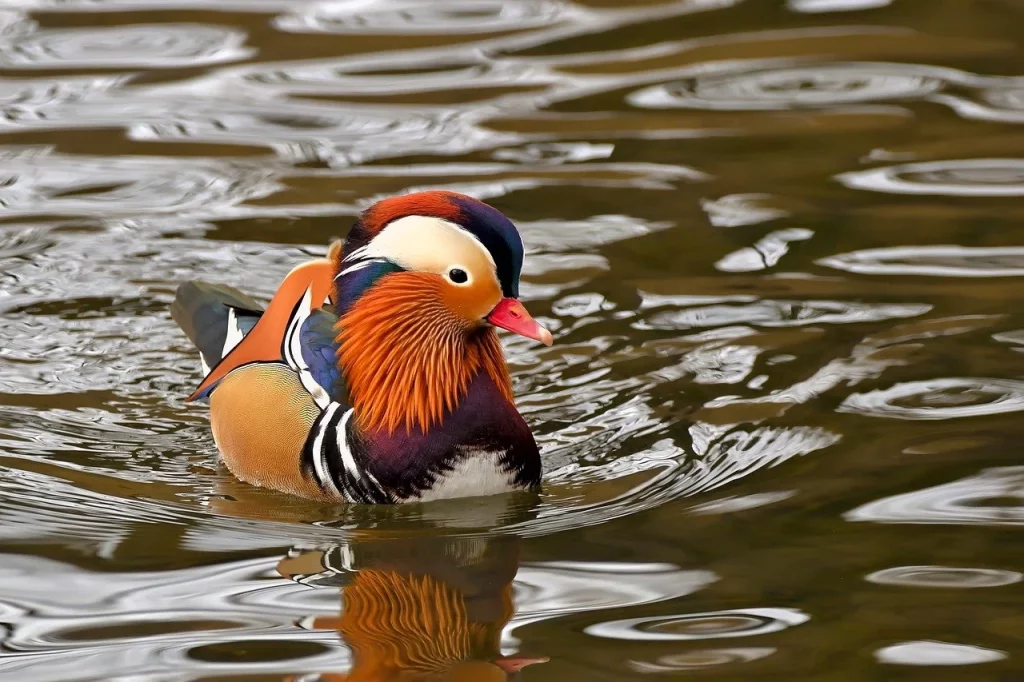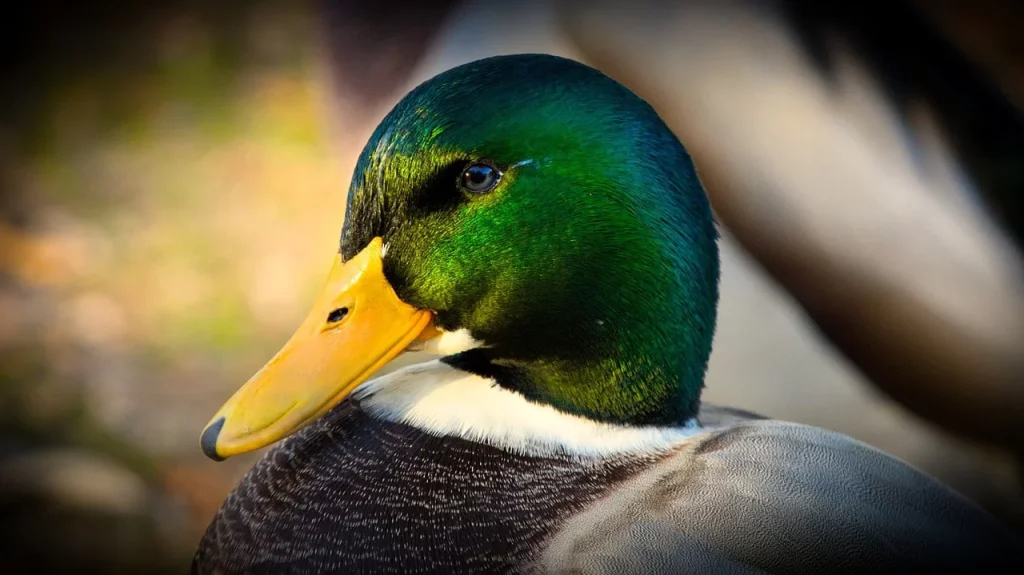In the world of ducks, every day is an adventure. Whether they’re navigating vast migrations, participating in elaborate mating rituals, or simply deciding which pond to grace with their presence, ducks lead a fascinating life.
With their vibrant personalities and array of colors, they’re like the rock stars of the avian world. And did you know that some ducks have been known to play tricks on each other? Yes, it seems ducks have a sense of humor too!
But here’s a feather-ruffling thought: how do ducks manage to keep their cool, even in the wildest of storms? Let’s find out everything together.
Be like a duck. Calm on the surface, but always paddling like the dickens underneath.
Michael Caine
Duck Facts
Before diving into the fascinating world of ducks, remember: I created a quiz at the article’s end. Read carefully to prove you’re a true expert.
- Ducks can sleep with one eye open, keeping one half of their brain awake. This ability allows them to watch for predators even while resting.
- Unlike many other birds, some species possess a remarkable ability to change their plumage color throughout the year, not just during breeding season.
- The echo of a duck’s quack doesn’t lack an echo; this is a myth. Instead, the sound frequency can be difficult for humans to discern when it echoes back.
- A group of ducks on the water is called a raft, while in flight, they are referred to as a flock.
- The longest recorded flight by a duck is over 7,000 miles in a single journey, showcasing their incredible endurance and navigation skills.
- Mallards, one of the most common species, can hybridize with over 60 other species, making them the most prolific interspecies breeders among all birds.
- The feet of these birds lack nerves or blood vessels that would freeze, allowing them to walk on ice or swim in icy water without feeling cold.
- A duck’s bill is equipped with sensitive nerves that help it find food in mud and sand, acting like a built-in metal detector.
- The vision of these creatures is remarkably adapted for underwater viewing, with a clear third eyelid that acts like goggles.
- Their feathers are so waterproof that even when diving underwater, their skin remains completely dry.
- Ducks are omnivorous and have a varied diet that can include insects, small fish, and aquatic plants.
- Baby ducks are born with the ability to walk and swim shortly after hatching, a critical survival skill.
- The process of oiling their feathers is crucial for their buoyancy and insulation. This is achieved by spreading oil from a gland near their tails.

- Some species can reach flying speeds of up to 70 mph, combining both speed and stamina in flight.
- Their quacks can vary in meaning, from signaling distress to attracting a mate or indicating contentment.
- Muscovy ducks are one of the few species that do not quack. Instead, they produce a hissing sound.
- Environmental changes can significantly impact their migration patterns, with shifts observed in timing and traditional routes.
- A duck’s love for grapes is not just about taste; grapes provide essential nutrients that are beneficial to their diet.
- Philopatry is a trait where ducks return to the place of their birth to mate and lay eggs, showing remarkable homing instincts.
- Their eggs come in a variety of colors, including white, blue, green, and even black, depending on the species.
- Remarkably, some ducks have been observed engaging in “imprinted” behaviors, following non-duck species or even humans they mistake for their parents.
- Northern Pintail ducks are noted for their extraordinary long tails, which can make up a quarter of their total body length.
- Due to their efficient digestive system, they can sleep in very short bursts throughout the day and night to maximize food absorption.
- Their ability to rotate their heads 360 degrees allows for an almost panoramic view of their surroundings, enhancing their vigilance.
- A single duck can eat up to half its body weight in food each day, an essential factor in their survival in varied environments.
- While most species are monogamous for a breeding season, some form bonds that last for several years.
- Their intricate feather patterns and colors are not just for attraction; they also provide camouflage against predators.
- Lead poisoning from ingested fishing weights and contaminated water sources is a significant health threat to these birds.

- City ducks often adapt to urban environments, utilizing man-made ponds and parks as habitats.
- The Wood Duck is known for its extraordinary ability to nest in trees, a rare habit among duck species.
- Conservation efforts have led to the successful recovery of several species once on the brink of extinction, showcasing the impact of protective legislation and habitat restoration.
- Duck racing is a unique sport in some cultures, where trained ducks race over water or through obstacle courses.
- Their predators include a wide range of animals, from large fish and turtles to birds of prey and humans.
- Anatidaephobia is the fear that somewhere, somehow, a duck is watching you, a humorous but recognized phobia.
- Their beaks contain a structure called the “nail” at the tip, crucial for foraging and defense.
- Some species can dive up to 240 feet in search of food, displaying remarkable diving skills.
- A duck’s feather color can be influenced by its diet, with certain nutrients affecting the vibrancy and hue of their plumage.
- Despite their light appearance, ducks have dense bones that aid them in diving and staying underwater.

- They play a vital role in ecosystem health, helping to control insect populations and distribute plant seeds.
- The sound of their wings during flight, known as the “whistling wings,” can be used to identify different species.
- In some cultures, they are symbols of luck and prosperity, often featured in art and literature.
- Seasonal migration routes can span continents, with ducks navigating using the stars, sun, and magnetic fields.
- Their social structures can be complex, with hierarchies and roles within groups, especially during breeding season.
- A duck’s memory is quite sharp; they can remember food sources and social partners from previous seasons.
- They use a variety of landscapes for their habitats, from freshwater lakes to coastal marshes and even deserts.
- Artificially bright lights can disorient migrating ducks, leading to increased mortality from collisions with buildings.
- Albinism and leucism can occur in duck populations, resulting in individuals with entirely white or patchy coloration.
- The phenomenon of autumn reproductivity in ducks is unique, where some species exhibit a second surge in reproductive hormones and behaviors in the fall, distinct from their primary spring breeding season.
- Ducks have been integral to biological pest control strategies, especially in rice paddies, where they consume vast amounts of insects and weeds without harming the crops.
- Feather preening in ducks is not just for cleanliness or waterproofing; it also plays a crucial role in social bonding and hierarchy establishment within groups.
Duck Myths

After diving into all these interesting facts about ducks, it’s time to shift our focus. We’ll now navigate through the myths, separating what’s true from what’s purely fictional about these cute birds.
- Ducks Quack Doesn’t Echo
It is commonly believed that a duck’s quack doesn’t produce an echo. However, this is a myth. Echoes are created when sound waves bounce off surfaces and return to the listener. Ducks’ quacks do indeed echo; it’s just that the echo might be difficult to hear clearly due to the quack’s acoustic properties. - Ducks’ Feet Freeze in Cold Water
Many think that their feet might freeze in cold water during the winter. In reality, a special circulation system in their legs helps to regulate their temperature, preventing their feet from freezing. This adaptation allows them to swim in icy water comfortably. - All Ducks Quack
While the quack of a duck is iconic, not all ducks actually quack. This misconception overlooks the rich variety of sounds ducks can make. For example, the male Mallard is known for its quack, but many duck species whistle, yodel, or make other sounds instead. - Ducks Can’t Fly
Some believe they are primarily aquatic and cannot fly. This couldn’t be further from the truth. Many species are migratory and possess strong flight muscles that enable them to travel long distances. Their flying abilities are essential for migration and escaping predators. - Feeding Bread to Ducks is Safe
Feeding them bread is often seen as a harmless activity. Unfortunately, bread is unhealthy for them, lacking the essential nutrients they need, and can lead to health issues. It’s recommended to feed ducks grains like oats or birdseed, which are much healthier for them.
No products found.
Duck Quotes

We continue our journey with some of my favorite quotes about ducks. Feel free to share yours in the comments so I can add them to the list as well.
A duck’s nest was found today near the trail on the dry open prairie with thirteen eggs in it…a pretty sight.
John James Audubon
John James Audubon describes the enchanting simplicity and beauty of nature through the discovery of a duck’s nest, showcasing his deep appreciation for wildlife.
The perils of duck hunting are great – especially for the duck.
Walter Cronkite
Walter Cronkite uses humor to highlight the danger ducks face during hunting season, reflecting on the human impact on wildlife with a touch of irony.
Life is like a duck: sleek on the top and paddling like hell underneath.
Anonymous
This anonymous saying echoes the sentiment that life’s calm appearance often belies the frantic efforts required beneath the surface.
There is nothing so annoying as to have two people talking when you’re busy interrupting.
Mark Twain
Although not directly about ducks, Mark Twain’s witty observation can whimsically apply to the quacking of ducks, using humor to comment on human conversations and interruptions.
I am like a duck: smooth on top and paddling like mad underneath.
Fred Shero
Fred Shero draws a vivid comparison to a duck to describe his approach to life and work, emphasizing effort and determination beneath a serene exterior.
Duck FAQ

Read carefully the following answers to some common questions, as this is your last piece of information before the quiz. Don’t disappoint me.
- Can ducks and chickens live together?
Yes, ducks and chickens can live together, sharing a coop and yard space. However, it’s important to ensure they have enough room and separate water sources, as ducks love to splash and can make the water messy, which isn’t ideal for chickens. - Are duck eggs good to eat?
Absolutely! Their eggs are delicious and can be used just like chicken eggs. They have a richer flavor and larger yolks, making them a favorite for baking and cooking. Just remember, they’re a bit bigger, so you might need to adjust recipes accordingly. - Can ducks fly?
Most duck species can fly, and they are actually quite good at it. Domestic ducks, especially heavier breeds, might not fly as well or as much as their wild counterparts, but they still retain the ability unless their wings are clipped for safety. - Are ducks birds?
Yes, they are birds. They belong to the waterfowl family, which also includes swans and geese. Ducks are characterized by their broad bills, webbed feet, and ability to float on water, making them well-adapted to aquatic environments. - How long do ducks live?
Their lifespan varies by species and whether they are wild or domesticated. Wild ducks can live 5 to 10 years, depending on the species and environmental factors. Domestic ducks, given proper care, can live longer, with some reaching up to 12 years or more.
No products found.
Duck Trivia

Welcome to the quack-tastic duck quiz! Remember, if you don’t get at least one question right, you’ll mysteriously find your bathtub occupied by a rubber duck army tomorrow morning.
Duck Merch
If you are a true duck fan, then you definitely need to check out our quackmire merchandise. You can find T-shirts, hoodies, mugs, and tote bags for your favorite designs. Feel free to check out all the other designs in our shop.
Conclusion
Ducks have a way of brightening our days, whether we’re watching them glide across a pond or listening to their cheerful quacks. These birds are not just beautiful; they are incredibly intelligent and full of surprises.
From their environmental impact to their social dynamics, ducks offer us a glimpse into the complexity of nature. They encourage us to pause and appreciate the small, beautiful moments in life.
So, let’s tip our hats to these splendid creatures and the joy they bring into our lives. Till next time, stay curious and explore more. Cheers.


